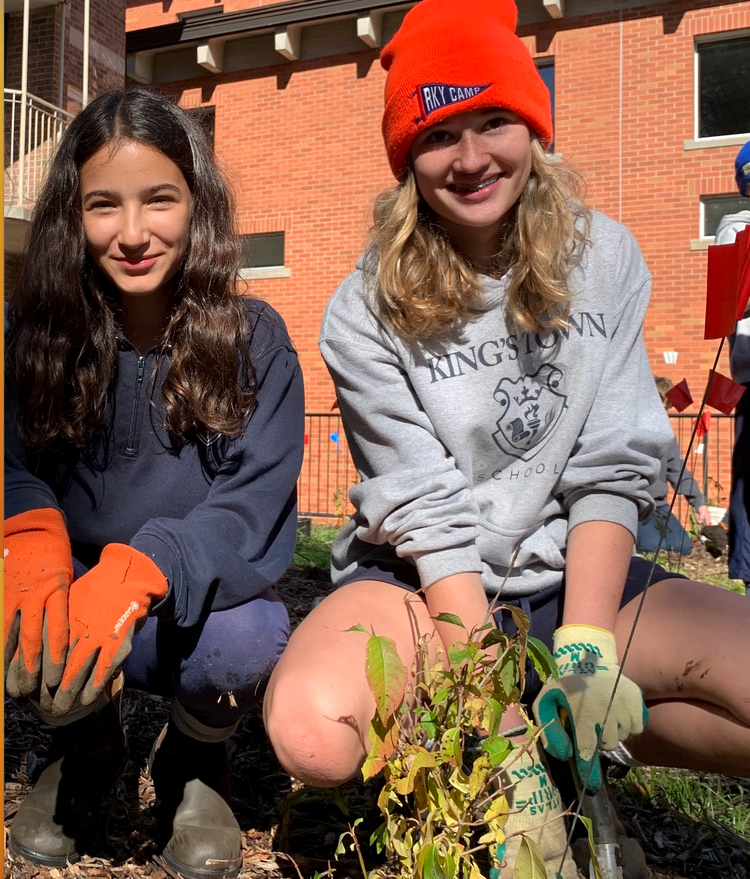
In collaboration with Kingston Frontenac Housing Corporation, we really enjoyed working with residents, all very excited to naturalize the courtyard of their apartment building at 205 Bagot Street. The building is managed by Kingston Frontenac Housing Corporation (KFHC). One of the reasons we were excited by this project is that it helps bring 3-30-300 tree equity to the residents of the apartment building as well as visitors to the Kingston Frontenac Public Library, which has windows on the north side of the building overlooking the site.
Our community

Residents are strongly committed to the quality of life for everyone in their building. While the largest demographic is seniors, more recently some young people have moved in. The residents involved in the project are keen to make the courtyard a beautiful, cool place for social gatherings that brings the community together. They were also keen to create habitat for birds and insects. One resident puts out multiple bird feeders. During the design sessions, several residents shared fond stories of their experience with and love of fireflies, which inspired the name for the forest reflecting their hope that fireflies will call the forests and gardens home.
About the site

This was a challenging site. It's a courtyard that's surrounded on three sides by buildings and on the fourth side by a stone wall and parking lot. It's baking hot and noisy in the summer thanks to the large air conditioning unit on the library situated to the south. Most of the trees and shrubs originally on site were removed by contractors during the library renovations. During the renovations they also built a retaining wall, replacing good soils with crushed gravel.
Fortunately, two beautiful Serviceberries near the patio were preserved. After digging test holes, we realized the soil wouldn't be able to support a full size Little Forest. Instead, after digging test holes across the courtyard, we identified five locations for Pocket Forests.
Preparing the soil

Due to the depleted soil conditions, we applied a 7-10 cm thick layer of compost following by a 12-15 cm thick layer of arborist woodchips to all of the Pocket Forest areas. We also added a thin layer of compost to three of pocket meadows sites and cover cropped the remaining pocket meadow site. We'll be planting some of the pocket meadows with plugs, others we'll be seeding fall 2025.

About the Pocket Forests and Pocket Meadows
Residents chose the name Firefly Little Forest as they're hoping the Pocket Forests and Pocket Meadows will attract Fireflies.

After thinking about their goals for the design of each of the Pocket Forests, residents chose to plant a Keystone Forest, Flower Forest, Noise Cancelling Forest, and a Shrub Haven. In total, we planted 97 trees and shrubs. We chose tough species who could handle the heat and drought. And, as they grow, they'll help cool the area.
In 2025, we'll plant four Pocket Meadows, transforming the courtyard into a beautiful oasis of biodiversity in the middle of Kingston.
Accessible paths will ensure residents with walkers and wheelchairs can enjoy the Pocket Forests, Pocket Meadows, and the birds and insects they'll attract
Stewardship

Spring 2025 we're convening the stewardship committee which will decide on the frequency and timing of stewardship activities. Planned activities include outreach both within the building and with neighbours, weeding, watering, and protecting the trees from rabbit predation. Since there were originally no tools or storage on site we'll also be looking into a solution to ensure there are tools available for residents stewarding the forests and meadows. We'll also have to keep an eye on the Virginia Creeper to ensure the vine doesn't smother the shrub thicket planted along the stone wall on the west side of the courtyard
Lessons learned

- Ensure you understand the soil across the entire site before going to far along the planning process. Due to construction, there can be significant differences in soil composition even on a small site.
- Learn from existing vegetation. After digging test holes to learn more about the soil conditions, we realized the turfgrass had given us a clues as there were significant differences in health of the turfgrass in the areas planted over fill vs the areas planted over healthy soil.
- Order compost by the yard rather than by the truckload. We ended up with too much compost as the truck was almost twice as big as the trucks which delivered compost to the Portsmouth Little Forest. Since the only place to dump the compost was an access area, we had to move it quickly so we used the whole load on the site.
- Conduct experiments. We're curious to see the results of our meadow experiments. Did cover crops reduce weed pressure? Was straw a good mulch for the meadow area?
Thanks
Our heartfelt thanks to the residents of 205 Bagot Street who helped design the planting, prepare the forest floor, and plant all of the seedlings. Gratitude as well to staff and students of King's Town School; Green Communities Canada for funding this amazing project, and to the City of Kingston for woodchips.

